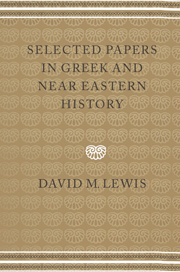Book contents
- Frontmatter
- Contents
- List of plates
- Preface
- Systems of reference
- GENERAL
- 1 Boeckh, Staatshaushaltung der Athener, 1817–1967
- 2 On the new text of Teos
- 3 The origins of the First Peloponnesian War
- 4 The federal constitution of Keos
- 5 The Athens Peace of 371
- 6 Preliminary notes on the Locri archive
- 7 Temple inventories in ancient Greece
- 8 Democratic institutions and their diffusion
- ATHENIAN
- NEAR EASTERN
- Bibliography
- Publications of David M. Lewis
- Indexes
7 - Temple inventories in ancient Greece
Published online by Cambridge University Press: 15 January 2010
- Frontmatter
- Contents
- List of plates
- Preface
- Systems of reference
- GENERAL
- 1 Boeckh, Staatshaushaltung der Athener, 1817–1967
- 2 On the new text of Teos
- 3 The origins of the First Peloponnesian War
- 4 The federal constitution of Keos
- 5 The Athens Peace of 371
- 6 Preliminary notes on the Locri archive
- 7 Temple inventories in ancient Greece
- 8 Democratic institutions and their diffusion
- ATHENIAN
- NEAR EASTERN
- Bibliography
- Publications of David M. Lewis
- Indexes
Summary
The task I have been given is to introduce you to some of the textual evidence for Greek metal–work. It is extremely copious and, particularly when it deals with gold and silver objects, it goes some way to making up for the loss of whole categories of objects which do not normally survive. With isolated exceptions, it has been neglected; my impression is that it has not really been explored by those interested in the development of metal–work, and that much remains to be done in correlating with real objects or representations of them.
My brief is to talk about inventories, that is, comprehensive documents drawn up by the responsible officials to list and publish the articles in their care. But, long before any text of this kind survives or is likely to have existed, one does get the odd text where individual donors commemorated their dedication with a separate inscription on stone or bronze. The practice is slightly different from writing the dedication on the object itself or, in the case, for example, of a statue, on its base. As the sixth century BC goes on, the text can become fairly explicit. The stele from Sigeion in the British Museum records the gift by Phanodikos of Prokonnesos to the citizens of Sigeion for use in the prytaneion, that is, for public entertainments, of a mixing–bowl, a stand and a strainer; the material is not specified. It has recently been suggested that the gift was thought so magnificent that Phanodikos was given the more than human status of a hero.
- Type
- Chapter
- Information
- Selected Papers in Greek and Near Eastern History , pp. 40 - 50Publisher: Cambridge University PressPrint publication year: 1997



